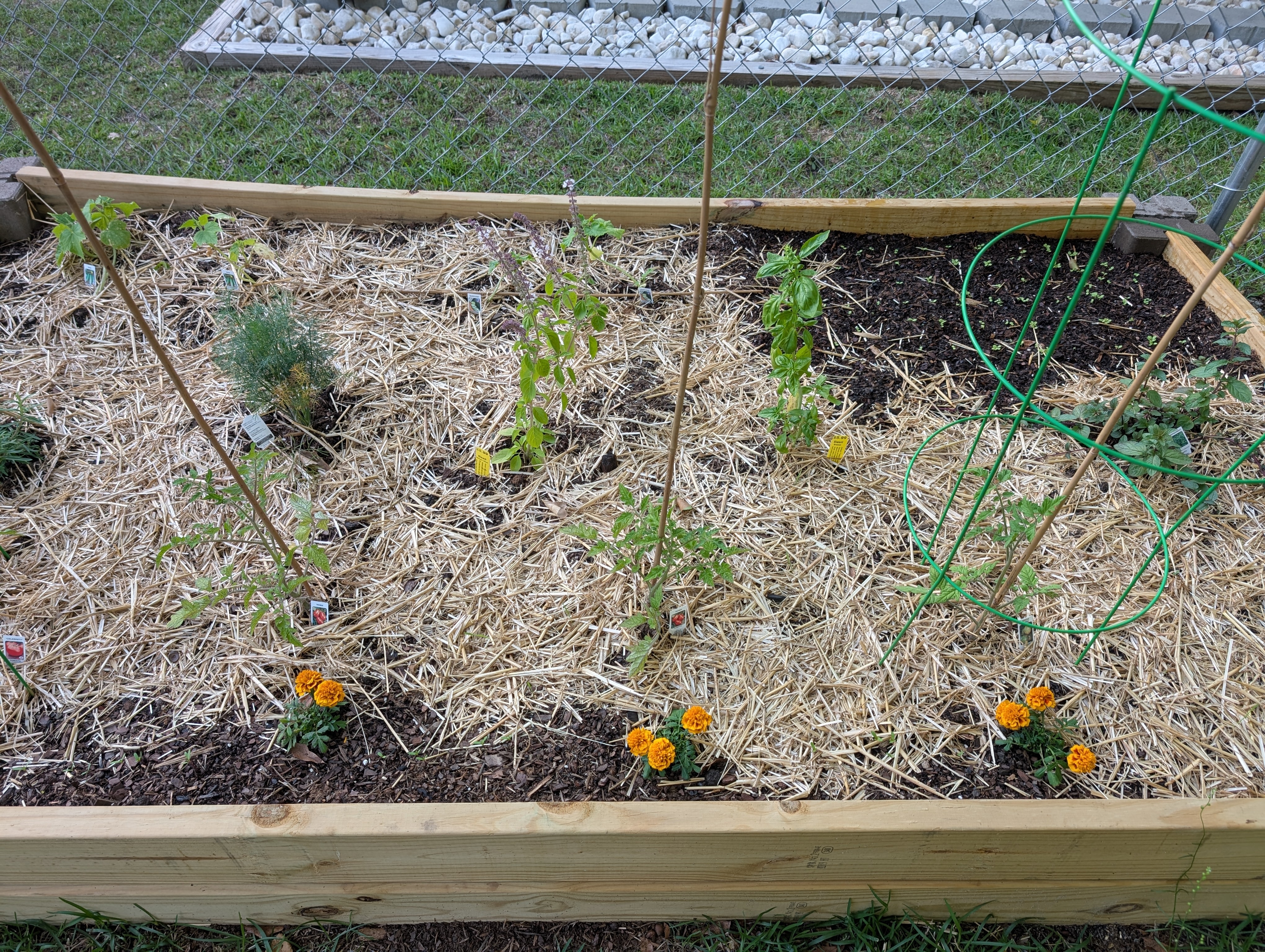I want to thank everyone who responded with advice for my last post.
Per the advice I received, I went ahead and found a 10-10-10 Scott’s fertilizer. I tried to apply it or the instructions, mixing it into the soil, and watered it in. I’m hoping for good things. One thing I’m curious about: the instructions indicate this particular product should be applied every two months, which seems like a long interval. Shouldn’t I be fertilizing more often? Did I choose the wrong kind?
Also, I finally got some straw and used it as mulch. It seems like it’s keeping the soil wetter for longer.
As for my plants: 
My potted tomato plant is taking off, more so than the ones I have in the actual bed. I installed a stake and a cage. I had primed of the first flower, but I believe it may be ready to bloom again. Do I need to keep trimming the flowers until it gets bigger?
 The onions I started later are taking off, too. I planted them as far apart as my instructions suggested, but I’m wondering if they need to be thinned out. The container is small, I know, but I’m hoping it’s just deep enough for them to succeed. I do worry if I’m keeping them too wet–the container is self-watering, so I’ve watered them less, but the soil is constantly moist. Will this be a problem later on?
The onions I started later are taking off, too. I planted them as far apart as my instructions suggested, but I’m wondering if they need to be thinned out. The container is small, I know, but I’m hoping it’s just deep enough for them to succeed. I do worry if I’m keeping them too wet–the container is self-watering, so I’ve watered them less, but the soil is constantly moist. Will this be a problem later on?
 My herbs (rosemary, dill, African and sweet basil, and peppermint) seem to be doing well. The African basil is flowering–do I need to cut these back for any reason?
My herbs (rosemary, dill, African and sweet basil, and peppermint) seem to be doing well. The African basil is flowering–do I need to cut these back for any reason?
My cucumbers are growing, but slowly. Three of them are definitely bigger, though one lags behind. I’m thinking the shallow depth of my bed is coming into play here. I wonder if I should try to transfer them to a deep pit like the one tomato I have already mentioned.
 The four tomato plants I have in the bed, determinate and semi-determinate, aren’t gaining a lot of height, but they do seem bushier. Again, I wonder if the shallowness of my bed is already holding them back. Stakes and cages are in place for the semi-determinate varieties, but I only have stakes for my two Roma plants.
The four tomato plants I have in the bed, determinate and semi-determinate, aren’t gaining a lot of height, but they do seem bushier. Again, I wonder if the shallowness of my bed is already holding them back. Stakes and cages are in place for the semi-determinate varieties, but I only have stakes for my two Roma plants.
 Here’s the peppermint I was warned would take over my bed given a chance. Do I need to go ahead and transfer it to a separate area or pot now?
Here’s the peppermint I was warned would take over my bed given a chance. Do I need to go ahead and transfer it to a separate area or pot now?
 My loose leaf lettuce seeds have sprouted, which is cool. I’m watching them closely to see how it grows. I didn’t fertilize these plants since they’re so young for fear of hurting them.
My loose leaf lettuce seeds have sprouted, which is cool. I’m watching them closely to see how it grows. I didn’t fertilize these plants since they’re so young for fear of hurting them.
Also, the marigold seeds I planted along the edges between the mature marigolds I planted have sprouted, as well.
 These pots are on the front side of my house. The small and medium size ones have more marigolds I planted from seed. I’m wondering if they’re getting big enough that I will need to thin them out.
These pots are on the front side of my house. The small and medium size ones have more marigolds I planted from seed. I’m wondering if they’re getting big enough that I will need to thin them out.
The big pot at the bottom has Shasta Daisies. They took a while to sprout, and are growing much more slowly than my other flowers.
 I’ve got two planters with Zinnias I sewed on my porch, and they’re really doing well. I’m wondering if and when I should think these too.
I’ve got two planters with Zinnias I sewed on my porch, and they’re really doing well. I’m wondering if and when I should think these too.
I appreciate any advice you guys may have as I progress. I’m trying to learn as much as I can, and you all have been an important part of my education so far.
If everyone is okay with it, I’ll continue to post updates. Thanks for your help!


Oh, one other thing: one of my cucumbers has a single bloom. Should I prune or leave it be? I got two pairs for pollination, but it’s on only the one that appears to have a bloom right now.
Cucumbers have two types of flowers. Male and female flowers. Male flowers have a thin stem under the flower. Female flowers have what looks like a mini-cucumber underneath of them. They only open for a few hours on one day so they never need pruning.
The blooming pattern for cucumber is referred to sex expression. There is moneocious (more males than females), predominantly female (more females than males) or gynecious (all female). This is controlled by the F-locus gene cluster.
Moneocious varieties are self fertile and only require 1 plant. These are all of the old OP types.
Predominately female varieties are all hybrids and need a moneocious pollinator (usually blended 1:10 or 1:15).
Gynecious varieties hybrids but have another cluster of genes that allow for parthenocarpy (seedless fruit). These varieties don’t need to be pollinated.
I’ve got Diva variety and another that just says “Burpless”, which I’ve found is a quality and not a variety. It appears the Diva is parthenocarphic. Not sure on the other, and that’s the one blooming. I guess I’ll find out. I’ll be on the lookout for male vs. female flowers on those.
Diva is a parthenocarpic gynecious variety. It will only produce female flowers.
Burpless = less bitter. Refers to a specific reduced bitterness gene originally from the dutch/English long cucumbers.